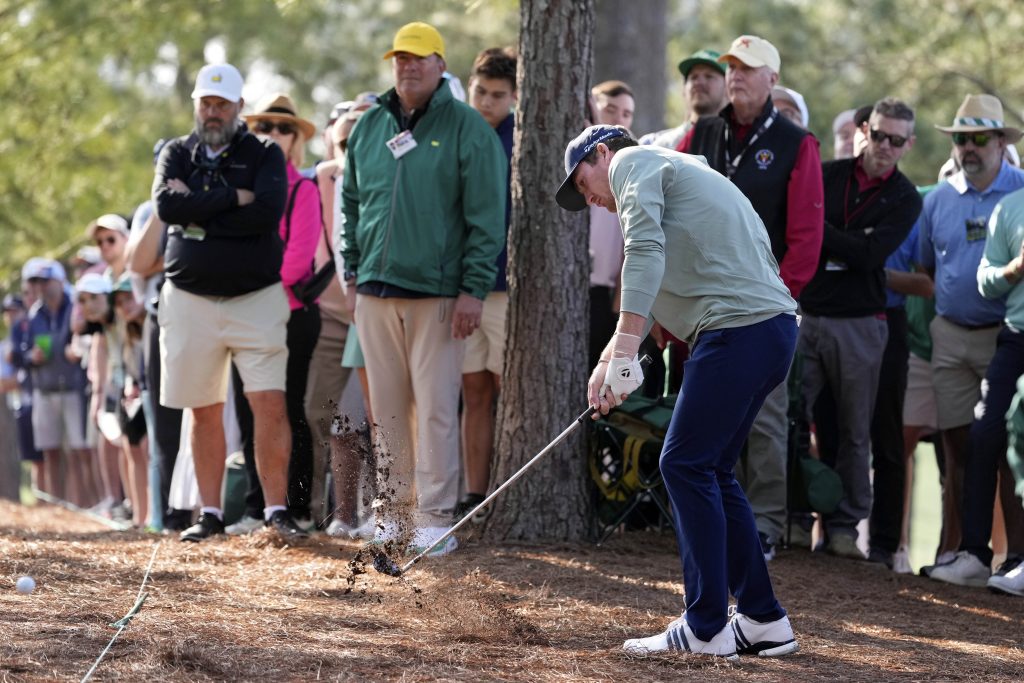Augusta, Ga. — Let’s start with this: Nick Dunlap is a good golfer. A very good golfer.
Before turning 21, he already has two wins on the PGA Tour. In the history of the sport, only eight players have done that — and only two others in the modern era: Tiger Woods and Tom Kim. Coming into this week’s Masters — still eight months shy of his 22nd birthday — he’s ranked 42nd in the world.
And then he proceeded to go out Thursday, shoot an 18-over par 90 and become a bit of a punching bag following Round 1 of the Masters. In the 89-year history of the tournament, only seven rounds have been worse. (The “record,” by the way, is 94.)
“Like trying to hold onto a rope and you can’t hold onto it,” he described the round.
Beaten down and severely disappointed by a round nine shots worse than anyone else in the field, Dunlap could have withdrawn and no one would have batted an eye. His father, Jim, even asked him if he was thinking about pulling out.
“Nope,” he told him, “I’m going to go out tomorrow and show people I can do it.”
Then he went out back of his Airbnb and hit a bunch of balls he’d bought from Target into the woods, ate Chipotle, as is his custom, and went to bed early.
He arrived at the driving range at Augusta National at noon on Friday, pulled out his driver and started pounding. Drive after drive — on a tee and off the deck. He’s in the midst of a swing change, which only adds to the struggle.
That and the rocket ship his golf career has been on.
He was a natural from the start, striping it from the first time his dad put a club in his hand as a young kid.
“I’m out here grinding,” his father would say to him, “and you’re striping it every time.”
He shot a 59 at age 12, was the Alabama state champion at 14, U.S. Junior Amateur champion at 17, committed to play at the University of Alabama at 18, became the U.S. Amateur champion at 19 and won his first PGA Tour event — the first amateur to win since Phil Mickelson in 1991 — at age 20.
One week later, he turned pro.
“We’d hoped he’d take it a little slower, finish out at Alabama,” Jim said. “But that win gave him a 2 1/2-year Tour exemption. How do you pass that up?”
Six months later, he won again, collecting a $720,000 paycheck — a not even 21-year-old trying to figure out how to live on his own and manage a suddenly sizable bank account. It’s a first-world problem, for sure, but it’s a hurdle nonetheless for an up-and-comer trying to figure out how to compete against the likes of Scottie Scheffler and Rory McIlroy.
Dunlap missed the cut at all three majors he played last year, including the Masters, and arrived at Augusta this week having missed three straight cuts.
A bogey on the first, third and fourth and a double at the fifth doomed his opening round from the start. And then things got worse. He carded four double bogeys on the back nine, sending him tumbling down the leaderboard … all the way to dead last.
After a 30-minute session on the range, in which he hit 63 balls — almost all drivers — he began his second round by spraying his tee shot on No. 1 into the left rough.
“He’s the one who shot 90,” a woman whispered to her husband as Dunlap walked up to the first green.
Still, he managed to scramble for par.
His tee shot at No. 2 flared right, but he managed another par, narrowly lipping out a birdie putt.
At 3, he again lost his drive to the right, his ball winding up on some pine straw underneath a pair of trees. That left him 145 yards out, with nothing but an uphill climb and a group of Georgia pines between himself and the green.
“What are you thinking?” his caddie asked.
“Split those trees with a draw,” he responded.
Standing behind him, it was impossible to tell which trees he planned on splitting. There were two forming a sort of staggered goal post, but they were barely 15 feet apart, so that couldn’t be it. The amateur eye looked right, where there was plenty more daylight.
Then he swung and 8 iron, splitting the goal posts down the middle. By the time he hiked up the hill, his ball had settled nine feet from the hole.
There was the magic.
He drained the putt, his first birdie of the tournament, then walked to the par 3 fourth.
“These are the moments that define you,” Jim said, standing by the fourth tee as his son waited for the green to clear in front of him. “Are you going to quit or …”
Or … drop your tee shot to within 11 feet and card a second straight birdie, which is what Nick Dunlap did. He’d card another at No. 8, putting him at 3-under on the front nine.
He kept it going on the back, scrambling for a few pars, not giving anything back. At 15, a par 5, he nearly holed his third shot, leaving him just eight inches for birdie.
At that point, he was in the hunt for another Masters record — most improvement from one round to the next. At 22 shot — +18 to -4 — Dunlap was one better than the record set way back in 1936.
The looseness of shots still weren’t worked out, but he was scrambling his way to one of the best rounds of the day.
A three-putt bogey at 16 set him back one, yet another wayward drive at 17 cost him another, then one more bogey at 18 cost him a third stroke. Not the finish he wanted, but an under-par round nonetheless after going 18-over the day before.
“It’s extremely rewarding and extremely humbling and frustrating at the same time,” he said after his round of 71. “I think professional golf is a very — can be a very lonely place, especially when you’re playing poorly. But it’s been a lot of fun. You get to travel to a lot of historic and unbelievable places like this one.”
For nearly 10 minutes he stood next to the clubhouse at Augusta National, answering question after question about the struggles in his game, the battle with his swing, the frustration of Thursday.
“You try to have fun even though it can be quite frustrating at times, and especially right now it’s hard to find something fun about it. But I got to come out and play Augusta today, so it could have been a lot worse.”
Augusta, Ga. — Let’s start with this: Nick Dunlap is a good golfer. A very good golfer.
Before turning 21, he already has two wins on the PGA Tour. In the history of the sport, only eight players have done that — and only two others in the modern era: Tiger Woods and Tom Kim. Coming into this week’s Masters — still eight months shy of his 22nd birthday — he’s ranked 42nd in the world.
Advertisement
Advertisement
Advertisement
And then he proceeded to go out Thursday, shoot an 18-over par 90 and become a bit of a punching bag following Round 1 of the Masters. In the 89-year history of the tournament, only seven rounds have been worse. (The “record,” by the way, is 94.)
“Like trying to hold onto a rope and you can’t hold onto it,” he described the round.
Beaten down and severely disappointed by a round nine shots worse than anyone else in the field, Dunlap could have withdrawn and no one would have batted an eye. His father, Jim, even asked him if he was thinking about pulling out.
“Nope,” he told him, “I’m going to go out tomorrow and show people I can do it.”
Advertisement
Advertisement
Advertisement
Then he went out back of his Airbnb and hit a bunch of balls he’d bought from Target into the woods, ate Chipotle, as is his custom, and went to bed early.
He arrived at the driving range at Augusta National at noon on Friday, pulled out his driver and started pounding. Drive after drive — on a tee and off the deck. He’s in the midst of a swing change, which only adds to the struggle.
That and the rocket ship his golf career has been on.
He was a natural from the start, striping it from the first time his dad put a club in his hand as a young kid.
“I’m out here grinding,” his father would say to him, “and you’re striping it every time.”
Advertisement
Advertisement
Advertisement
He shot a 59 at age 12, was the Alabama state champion at 14, U.S. Junior Amateur champion at 17, committed to play at the University of Alabama at 18, became the U.S. Amateur champion at 19 and won his first PGA Tour event — the first amateur to win since Phil Mickelson in 1991 — at age 20.
One week later, he turned pro.
“We’d hoped he’d take it a little slower, finish out at Alabama,” Jim said. “But that win gave him a 2 1/2-year Tour exemption. How do you pass that up?”
Six months later, he won again, collecting a $720,000 paycheck — a not even 21-year-old trying to figure out how to live on his own and manage a suddenly sizable bank account. It’s a first-world problem, for sure, but it’s a hurdle nonetheless for an up-and-comer trying to figure out how to compete against the likes of Scottie Scheffler and Rory McIlroy.
Advertisement
Advertisement
Advertisement
Dunlap missed the cut at all three majors he played last year, including the Masters, and arrived at Augusta this week having missed three straight cuts.
A bogey on the first, third and fourth and a double at the fifth doomed his opening round from the start. And then things got worse. He carded four double bogeys on the back nine, sending him tumbling down the leaderboard … all the way to dead last.
After a 30-minute session on the range, in which he hit 63 balls — almost all drivers — he began his second round by spraying his tee shot on No. 1 into the left rough.
“He’s the one who shot 90,” a woman whispered to her husband as Dunlap walked up to the first green.
Advertisement
Advertisement
Advertisement
Still, he managed to scramble for par.
His tee shot at No. 2 flared right, but he managed another par, narrowly lipping out a birdie putt.
At 3, he again lost his drive to the right, his ball winding up on some pine straw underneath a pair of trees. That left him 145 yards out, with nothing but an uphill climb and a group of Georgia pines between himself and the green.
“What are you thinking?” his caddie asked.
“Split those trees with a draw,” he responded.
Standing behind him, it was impossible to tell which trees he planned on splitting. There were two forming a sort of staggered goal post, but they were barely 15 feet apart, so that couldn’t be it. The amateur eye looked right, where there was plenty more daylight.
Advertisement
Advertisement
Advertisement
Then he swung and 8 iron, splitting the goal posts down the middle. By the time he hiked up the hill, his ball had settled nine feet from the hole.
There was the magic.
He drained the putt, his first birdie of the tournament, then walked to the par 3 fourth.
“These are the moments that define you,” Jim said, standing by the fourth tee as his son waited for the green to clear in front of him. “Are you going to quit or …”
Or … drop your tee shot to within 11 feet and card a second straight birdie, which is what Nick Dunlap did. He’d card another at No. 8, putting him at 3-under on the front nine.
Advertisement
Advertisement
Advertisement
He kept it going on the back, scrambling for a few pars, not giving anything back. At 15, a par 5, he nearly holed his third shot, leaving him just eight inches for birdie.
At that point, he was in the hunt for another Masters record — most improvement from one round to the next. At 22 shot — +18 to -4 — Dunlap was one better than the record set way back in 1936.
The looseness of shots still weren’t worked out, but he was scrambling his way to one of the best rounds of the day.
A three-putt bogey at 16 set him back one, yet another wayward drive at 17 cost him another, then one more bogey at 18 cost him a third stroke. Not the finish he wanted, but an under-par round nonetheless after going 18-over the day before.
Advertisement
Advertisement
Advertisement
“It’s extremely rewarding and extremely humbling and frustrating at the same time,” he said after his round of 71. “I think professional golf is a very — can be a very lonely place, especially when you’re playing poorly. But it’s been a lot of fun. You get to travel to a lot of historic and unbelievable places like this one.”
For nearly 10 minutes he stood next to the clubhouse at Augusta National, answering question after question about the struggles in his game, the battle with his swing, the frustration of Thursday.
“You try to have fun even though it can be quite frustrating at times, and especially right now it’s hard to find something fun about it. But I got to come out and play Augusta today, so it could have been a lot worse.”












